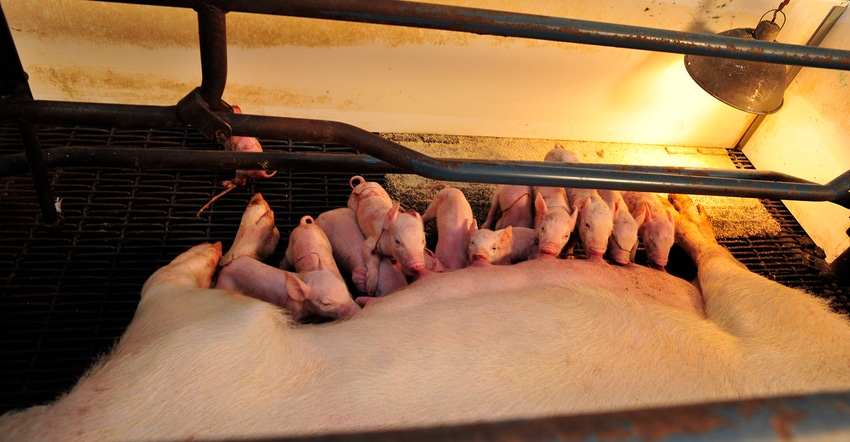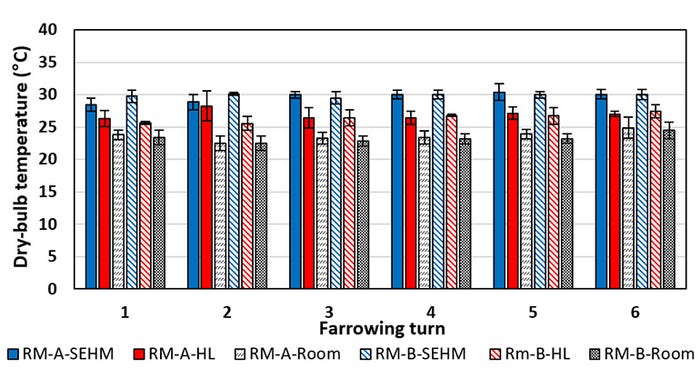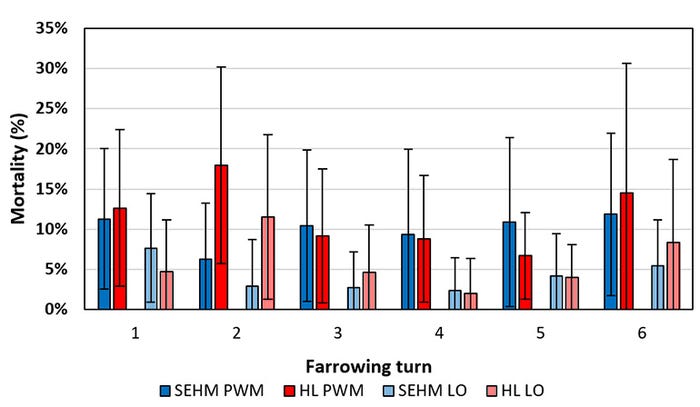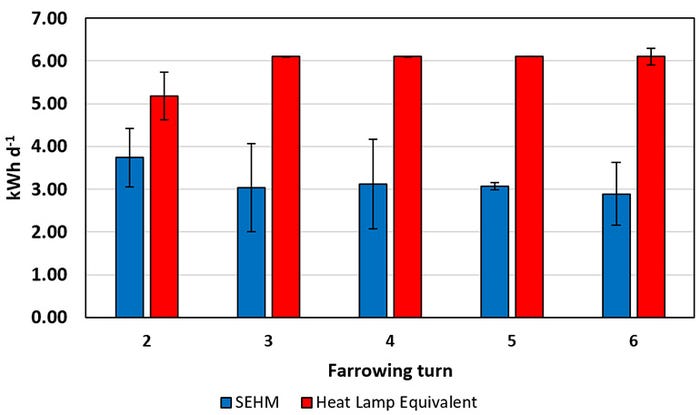Evaluation of supplemental heat source for creep areas
Results showed that the SEHM provided a warmer creep environment for the piglets, did not impact ADG, reduced laid-on mortalities and consumed less electricity.
January 21, 2020

Pre-weaning mortality is a major economic and productivity inhibitor for the U.S. swine industry. Historical trends show an increasing total born while the number weaned has stayed constant. There are several causes of PWM with laid-on piglets being one of the more prominent causes that can be attributed to numerous influencing factors, including health, age, sow temperament and thermal environment.
A piglet, especially a newborn, requires a warm draft-free environment, capable of providing the necessary heat gains for the piglet to maintain its body temperature. Commonly used supplemental heat sources provide an adequate amount of heat but lack power adjustability and the ability to prevent drafts.
The goal of this study was to evaluate the piglet production performance and consequent economic impact of a semi-enclosed heated microclimate under commercial sow farm conditions.
The SEHM (FarrPro Inc., Iowa City, Iowa) featured a parabolic-shaped shield to cover two adjacent stalls and an independently controlled ceramic heat element interfaced with a commercial controller (ControlTech, Bondurant, Iowa). Twelve SEHM units were installed in two of nine farrowing rooms at a 1,000-head commercial sow farm. Each room housed 24 farrowing stalls, so six SEHMs were randomly placed in each room.
For comparison, heat lamps with 125-watt bulbs were utilized in the remaining stalls. Dry-bulb and black globe temperature were monitored in the creep area of three SEHM and HL stalls in each room, along with the energy consumption of each SEHM. Litter average daily gain (from Day 3 to 18), PWM overall and by cause were monitored for six farrowing turns in each room. Multiple records were collected (farm's farrowing records, farm's production and mortality weights for ADG) to assess PWM and all sources had to match the number of piglets in the litter and the mortalities.
Over the six farrowing turns, 113 SEHM litters and 101 HL litters were included in the study. The parity distribution was broken down into three groups (young Parity 1-2, prime Parity 3-5 and geriatric Parity 6 and up) and was evenly distributed across the two supplemental heat treatments. Throughout the course of the study, the farm was porcine reproductive and respiratory syndrome virus-negative. In each room, the SEHM averaged a higher air temperature (Figure 1).

Mean ADG for the six turns was not significantly different (SEHM = 252 hd-1 d-1 and HL = 260 g hd-1 d-1, p=0.26). The overall PWM difference was not significantly different (SEHM = 9.67% and HL = 12.04%, p=0.08; Figure 2). The difference in the percentage of laid-on mortalities was significantly different, with SEHM = 4.05% and HL = 6.04% laid-on mortalities. The only significantly different parity group and supplemental heat source was HL and geriatric sows, with a PWM = 19.23% and laid-ons = 11.04%. Compared to SEHM and geriatric sows, the PWM = 10.16% and laid-ons = 5.07%. This suggests that the greatest benefit of the SEHM is with the older sows.

Only SEHM units that had both litters farrow on the same day were considered for electrical consumption assessment. The HL usage was assumed from a constant bulb wattage and was verified on site. The first turn of electricity consumption was not used as the SEHM units were updated at the end of the turn to more efficient units. The SEHM units used a significantly lower amount averaging 3.25 kWh per day compared to 6 kWh per day (2 x 125 W lights bulbs; Figure 3).

Overall, results showed that the SEHM provided a warmer creep environment for the piglets, did not impact ADG, reduced laid-on mortalities and consumed less electricity. A limitation of this study is that the pilot study design may not fully represent a practical installation.
This work is published in Animals, see the following reference for more details, or contact Ramirez for more information.
Smith, B. C., Ramirez, B. C., Hoff, S. J. & Greiner, L. L. (2019). Pilot-Scale Assessment of a Novel Farrowing Creep Area Supplementary Heat Source. Animals, 9(11), 996. .
Sources: Benjamin C. Smith, Brett C. Ramirez, Steven J. Hoff and Laura L. Greiner, who are solely responsible for the information provided, and wholly own the information. Informa Business Media and all its subsidiaries are not responsible for any of the content contained in this information asset.
You May Also Like



